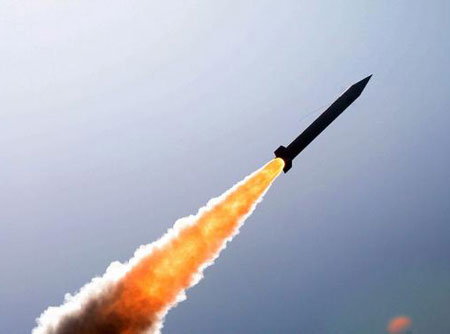Launch missiles with waste water
US engineers have found a way to produce fuel for rocket engines from waste water.
Nitrous oxide (N 2 O) is a colorless, sweet and gas-producing gas. Although it is a greenhouse gas group, it burns into oxygen (O 2 ) and nitrogen (N) when burned.

During the combustion of N 2 O gas, the rocket engine produces only hot oxygen and nitrogen gas.
Photo: wordpress.com.
Physorg said, Professor Brian Cantwell, a Stanford University rocket engine specialist in the US, and some students wanted to turn nitrous oxide (N2O) into an energy source. If you do that, you will have a huge supply of energy, and the speed of global warming will also decrease.
Cantwell exchanged ideas with Craig Criddle, Stanford University's professor of construction and environment. Criddle said the sewage in the culverts contained an anaerobic bacteria (growing without oxygen) capable of turning N into N 2 O.
In the process of 'processing' bacteria also produce methane (NH 4 ) - a gas that humans can use to produce electricity.
Cantwell's rocket engine - designed for use in spacecraft - can burn a large amount of N 2 O to produce heat. In the Stanford University press release, Cantwell said the engine could produce temperatures up to more than 5,400 degrees C and emit N and O 2 at a rate of about 150 m / s.
To visualize the benefits that Cantwell's technology brings, we need to understand the process of waste disposal. In most US waste treatment plants, people pump oxygen into waste water to create conditions for bacteria to decompose organic matter. N is one of the products created by that process.
However, this approach is both expensive and complicated. Using anaerobic bacteria is a cheaper and simpler way. The biggest weakness of a bacterial solution is that it produces N 2 O - a gas harmful to the environment. Rocket engines will solve that problem.
Cantwell's group claims their technology can replace the technology being used in waste treatment plants across the United States and help poor countries produce more clean water for people. It can also be used to extract N from groundwater below fields fertilized with chemicals.
- Japan: Missiles fall back to the launch pad in just a few seconds and then explode
- Video: Missiles carry satellites falling after launch
- Russian missiles fell into the sea immediately after leaving the platform
- America develops technology to separate water from animal waste
- How is the 'launcher and forget' weapon other than 'launch and run'?
- 6 facts that make you change the way you think about using water
- SpaceX will launch more missiles than any country this year
- Close up of the missile journey from the launch pad, move and hit the target
- Chinese missiles exploded and fell near a village inhabited by people after the launch
- The numbers said after the successful launch of the Falcon Heavy missile
- New technology to treat industrial wastewater into clean water
- China developed missiles that could launch from aircraft
 Why do potatoes have eyes?
Why do potatoes have eyes? 'Tragedy' the world's largest carnivorous life: Death becomes ... public toilet
'Tragedy' the world's largest carnivorous life: Death becomes ... public toilet Tomatoes were once considered 'poisonous' for 200 years
Tomatoes were once considered 'poisonous' for 200 years Detecting microscopic parasites on human face
Detecting microscopic parasites on human face